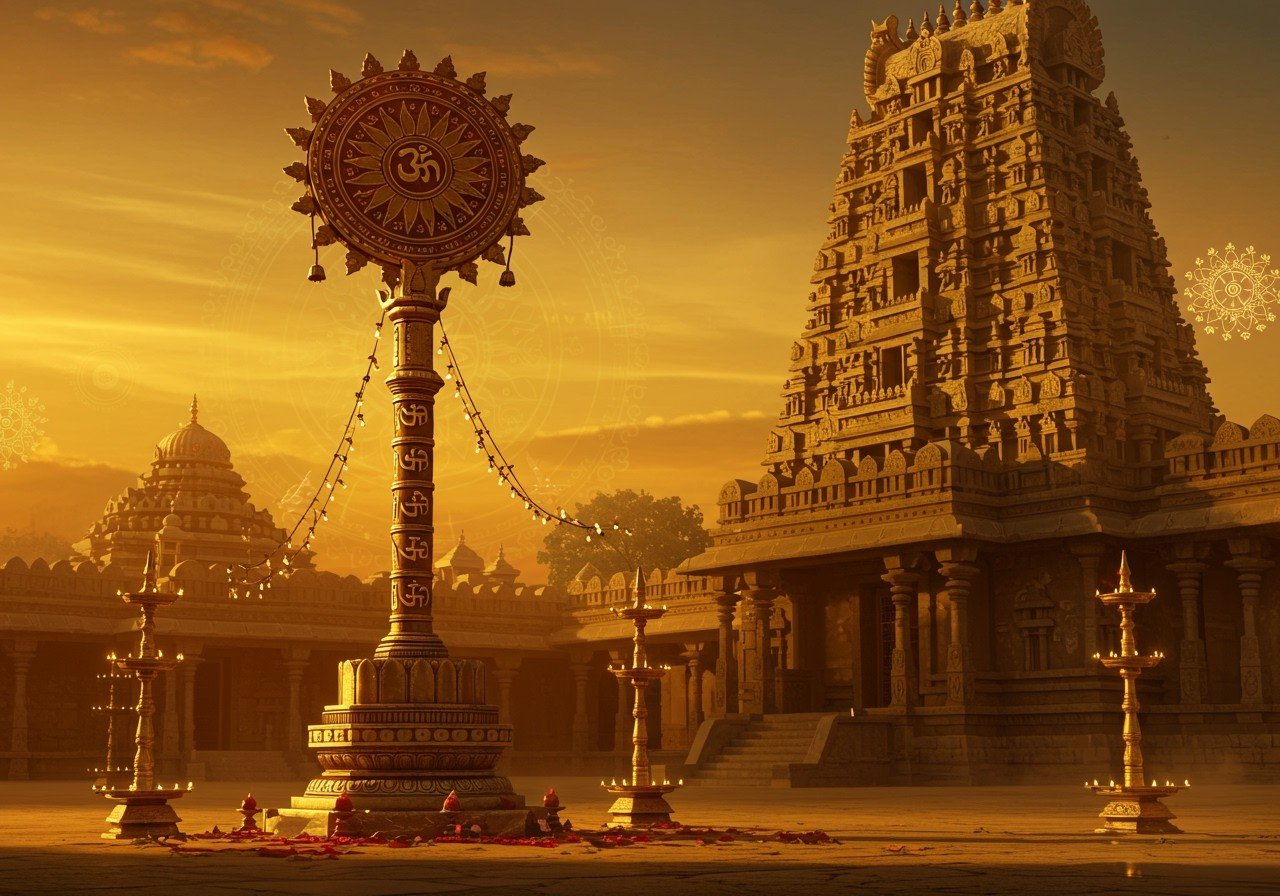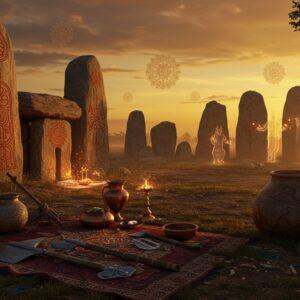
Imagine stepping into the serene courtyard of a South Indian temple. Amidst the intricate carvings and the hushed reverence, your eyes are drawn to a majestic pillar rising towards the heavens – the Dwajasthambam. More than just a striking architectural element, it’s a powerful symbol deeply woven into the fabric of Hindu tradition. Also known as Kodimaram, this sacred flagstaff, often positioned between the Gopuram (entrance tower) and the Maha Mandapa (main hall), holds a profound significance for devotees.
A Journey Through Time: The History of Dwajasthambam
The tradition of the Dwajasthambam has roots in ancient times, possibly originating from the symbolic flags adorning chariots during wars between gods and demons. These flags, representing power and victory, gradually evolved into the majestic pillars we see today. Initially, these flagstaffs were temporary structures, erected to mark auspicious events and festivals. Over time, they became permanent fixtures, signifying the temple’s sanctity and the enduring presence of the divine.
Unveiling the Symbolism: A Bridge Between Earth and Heaven
- Connection to the Divine: The Dwajasthambam acts as a spiritual conduit, linking the earthly realm with the heavens. It symbolizes the devotee’s aspiration to connect with the divine, fostering a sense of closeness to God. It’s a visual representation of our prayers rising upwards.
- Triumph Over Ignorance: Like a beacon of hope, the Dwajasthambam signifies the quest for knowledge and enlightenment, urging us to rise above ignorance and move closer to spiritual understanding. It represents the journey from darkness to light.
- The Spinal Cord: According to the Agamas, ancient scriptures on temple architecture, the Dwajasthambam represents the spinal cord, the vital energy channel within the human body. This emphasizes its role as the spiritual core of the temple.
- Embodiment of Divine Power: The Dwajasthambam is believed to channel the divine energy of the deity into the temple, imbuing the sacred space with power and blessings. It’s a conduit for divine grace.
- The Holy Trinity: The three horizontal perches (Mekhala or Mekalai) often seen atop the Dwajasthambam symbolize the Trimurtis – Brahma, Vishnu, and Shiva – representing the creative, preserving, and transformative forces of the universe. It’s a reminder of the divine balance within creation.
- Auspicious Placement: The placement of the Dwajasthambam, particularly in the northwest corner of the temple, is considered highly auspicious, enhancing its spiritual significance.
- Victory and Celebration: The act of hoisting the flag atop the Dwajasthambam symbolizes victory and the triumph of good over evil. It’s a joyous affirmation of faith.
Ritual Significance and Festive Celebrations
The Dwajasthambam plays a pivotal role in temple festivals, especially during the ‘Dwajarohanam’ ritual. This sacred ceremony involves hoisting a new flag on the Dwajasthambam, marking the commencement of the festival and inviting the divine presence. The flag often depicts the deity’s ‘vahana’ (vehicle), such as Nandi for Lord Shiva or Garuda for Lord Vishnu. Other auspicious symbols, like the sun, moon, trident, or shank, might also adorn the flag, each carrying specific meanings and blessings.
- Focus of Divine Energy: The Dwajasthambam is considered a focal point of divine energy, radiating blessings to all who enter the temple. It’s where earth and heaven meet.
- A Welcoming Beacon: The hoisted flag announces the ongoing festival, inviting all to participate in the celebrations and receive the deity’s blessings. It’s an open invitation to experience the divine.
- Spiritual Protection: The Dwajasthambam is believed to protect the temple from negative energies, ensuring a sacred and peaceful atmosphere for worship. It’s a guardian of the sacred space.
- Guidance and Devotion: The presence of Garuda on the Dwajasthambam, for instance, symbolizes his eagerness to guide devotees towards Lord Vishnu, fostering a deeper connection with the divine.
- Reverence and Rituals: Devotees often offer prayers to the Dwajasthambam before entering the main sanctum, acknowledging its spiritual significance. In temples practicing Shodasopachara puja (16 acts of worship), many of these offerings are also presented to the Dwajasthambam along with the main deity.
- Aakasa Deepam: During the Karthika month, the Dwajasthambam is used to hoist the ‘Aakasa Deepam’ (celestial lamp), a symbolic offering of light to the heavens.
Poojn.in: Your Partner in Preserving Traditions
At poojn.in (https://www.poojn.in), we understand the deep significance of these sacred traditions. We offer a wide selection of authentic puja items, including pooja samagri, divine statues, holy books, and more, to help you create a sacred space in your home and perform rituals with reverence. Explore our culturally significant items and holy clothing to enhance your spiritual journey.
Discover a wide array of exquisite statues, like the Ram Sita Laxman Hanuman statue, the Lakshmi Ganesh Murti, perfect for Diwali, or the intricately crafted Murugar Seval Kodi. We also offer essential items like the Pure Iron Degchi Dhoop Dhani to create a sacred atmosphere in your home.
The Dwajasthambam: A Timeless Symbol of Faith
The Dwajasthambam stands as a timeless testament to the rich cultural and spiritual heritage of India. It’s a symbol of hope, victory, and the enduring connection between humanity and the divine. As we continue to cherish and preserve these traditions, the Dwajasthambam serves as a powerful reminder of our spiritual roots and the vibrant tapestry of our faith.
Explore more about sacred temples and their significance on our blog, featuring articles on the Sthaneshwar Mahadev Temple, the Hidimba Devi Temple, the Martand Sun Temple, and the Shankaracharya Temple.


